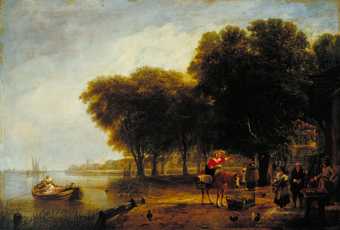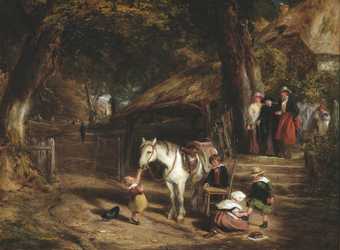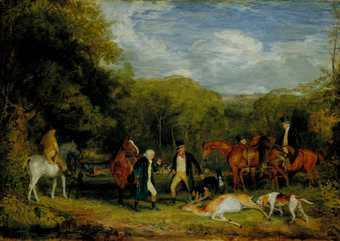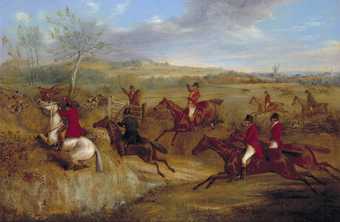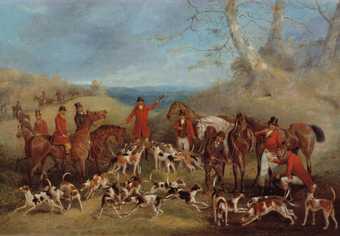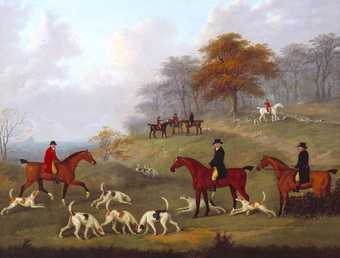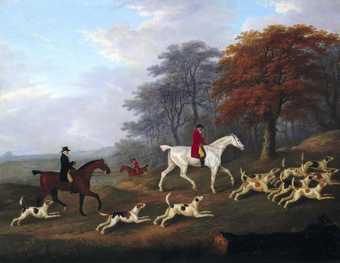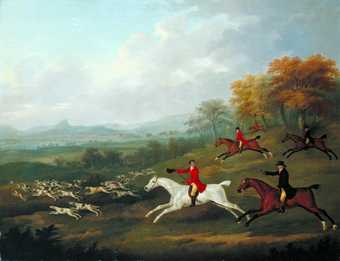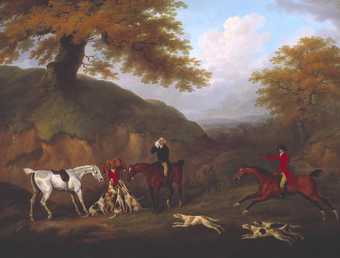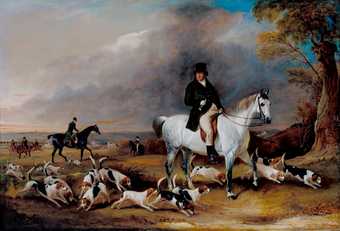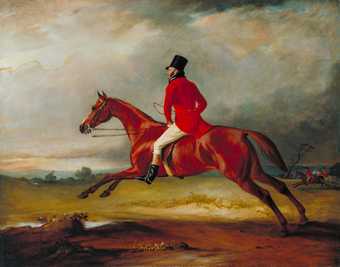
Not on display
- Artist
- Henry Thomas Alken 1785–1851
- Medium
- Oil paint on canvas
- Dimensions
- Support: 451 × 648 mm
- Collection
- Tate
- Acquisition
- Presented by Paul Mellon through the British Sporting Art Trust 1979
- Reference
- T02354
Catalogue entry
[from] THE BELVOIR HUNT: a set of four c.1830–40 [T02352-T02355]
T02354 3. FULL CRY
Inscribed ‘H Alken’: (1) and (4) lower left; (2) and (3) lower right
Oil on canvas, each 17 3/8 × 25 1/2 (44 × 64.5)
Presented by Mr Paul Mellon KBE through the British Sporting Art Trust 1979
Prov: ...; Arthur Ackermann & Son Ltd., from whom purchased by Paul Mellon 1964.
Exh: British Sporting Paintings, Fermoy Art Gallery, King's Lynn 1979 (24–27).
Lit: Egerton, 1978, p.253, no.275, 1–4.
The Belvoir is one of the oldest and most celebrated hunts; it dates from 1750 and became a foxhound pack in 1762. The kennels throughout the Hunt's history have been at Belvoir Castle. Its country lies in Leicestershire and Lincolnshire, adjoining that of the Quorn and the Cottesmore at Melton Mowbray. Alken's scenes catch something of the qualities, half-dandy, half-daredevil, deliberately cultivated by Meltonian sportsmen; in ‘The Meet’, one rider nonchalantly smokes a cheroot as he waits, and in ‘The Death’ one accepts a cigar from another's silver case, but (2) and (3) show most of the field taking fences and ditches with considerable verve and aplomb. The variety of landscape in the four scenes illustrates ‘Brooksby's’ comments on the Belvoir country (quoted in Baily's Hunting Directory, 1966–7, p.10): ‘You may ride over small grass meadow, broad grazing land, light heath and heavy plough. It is impossible to sum up its characteristics in a sentence or two’.
If the suggested dating of 1830–40 is correct, the huntsman in Alken's scenes is Thomas Goosey, who had been whipper-in to the Belvoir from 1794 to 1816, and was its huntsman from 1816 to 1842. ‘Nimrod’ described Goosey as ‘being just what a man should be to assist hounds in a flying country like his. He had an eye like a hawk - very quick to his points, and was a more than commonly sportsmanlike-looking person on his horse’ (C. J. Apperley, Nimrod's Hunting Reminiscences, 1843, ed. 1926, p.129). The Mastership of the Belvoir was held by the Dukes of Rutland until 1896, except between 1830 and 1859; during that period (which almost certainly includes the period of Alken's scenes) the then Duke of Rutland, having retired from the hunting field, gave the Mastership to his nephew, Lord Forester.
Published in:
The Tate Gallery 1978-80: Illustrated Catalogue of Acquisitions, London 1981
Explore
- architecture(30,960)
-
- agricultural(1,066)
-
- barn(77)
- recreational activities(2,836)
-
- hunting(164)
- group(4,227)
- UK counties(19,585)
-
- Leicestershire(146)
- England(19,202)
- England, Midlands(1,861)
- transport: land(2,189)
-
- riding(512)
You might like
-
Sir Augustus Wall Callcott Dutch Peasants Waiting the Return of the Passage Boat
exhibited 1834 -
William Collins Sunday Morning
?exhibited 1836 -
John Frederick Lewis Buck-Shooting in Windsor Great Park
1825 -
Henry Thomas Alken The Belvoir Hunt: The Meet
c.1830–40 -
Henry Thomas Alken The Belvoir Hunt: Jumping into and out of a Lane
c.1830–40 -
Henry Thomas Alken The Belvoir Hunt: The Death
c.1830–40 -
James Barenger Jonathan Griffin, Huntsman to the Earl of Derby’s Staghounds
1813 -
John Nost Sartorius The Earl of Darlington Fox-Hunting with the Raby Pack: Drawing Cover
1805 -
John Nost Sartorius The Earl of Darlington Fox-Hunting with the Raby Pack: Going to Cover
1805 -
John Nost Sartorius The Earl of Darlington Fox-Hunting with the Raby Pack: Full Cry
1804 -
John Nost Sartorius The Earl of Darlington Fox-Hunting with the Raby Pack: The Death
?1804–5 -
John Ferneley I John Burgess of Clipstone, Nottinghamshire, on a Favourite Horse, with his Harriers
1838 -
John Ferneley II Hunt Scurry
1832 -
John Ferneley I Major Healey, Wearing Raby Hunt Uniform, Riding with the Sedgefield Hunt
c.1833 -
Henry Thomas Alken A Hunting Scene
date not known

